Human Services: Exploring the History and Regulations of Midwifery
VerifiedAdded on 2022/08/23
|8
|2268
|35
Essay
AI Summary
This essay provides a comprehensive overview of the human service profession of midwifery. It begins with an introduction to midwifery, defining its role in assisting expectant mothers during gestation, labor, and post-delivery. The essay details the main duties and responsibilities of midwives, including creating care plans, providing advice, offering emotional support, conducting screening tests, and assessing pregnancy risks. It then traces the historical development of midwifery, highlighting its origins in response to the scarcity of doctors and the role of slavery in shaping the profession. The essay further explores the relevant policies and regulations governing midwifery practices, emphasizing the importance of licensing, quality of care, and adherence to standards. Finally, the essay recommends changes to improve the profession, such as continuous training, public recognition of licensed midwives, and stricter enforcement of regulations. The essay concludes by summarizing the successes and downfalls of midwifery practice and offering recommendations for future development.
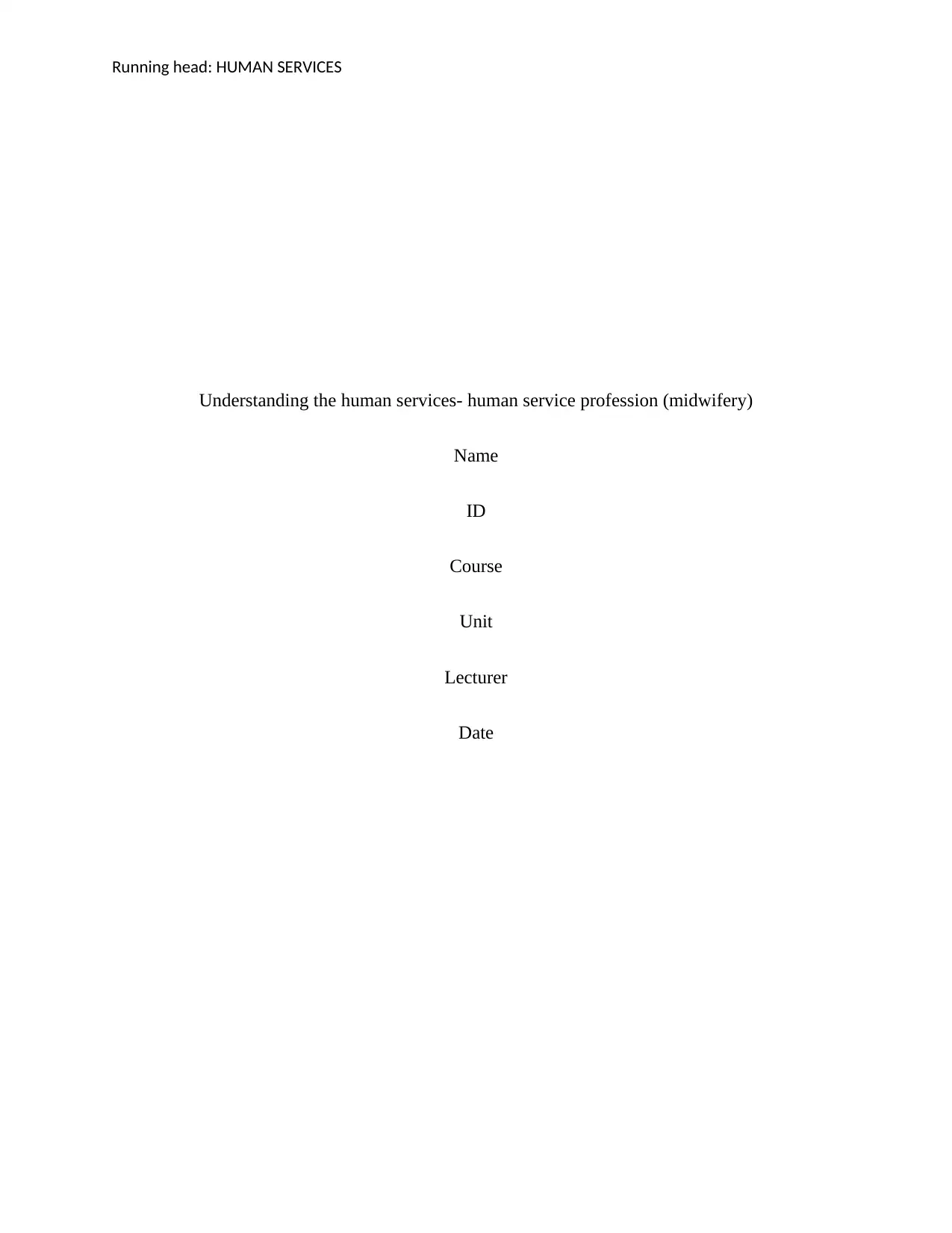
Running head: HUMAN SERVICES
Understanding the human services- human service profession (midwifery)
Name
ID
Course
Unit
Lecturer
Date
Understanding the human services- human service profession (midwifery)
Name
ID
Course
Unit
Lecturer
Date
Paraphrase This Document
Need a fresh take? Get an instant paraphrase of this document with our AI Paraphraser
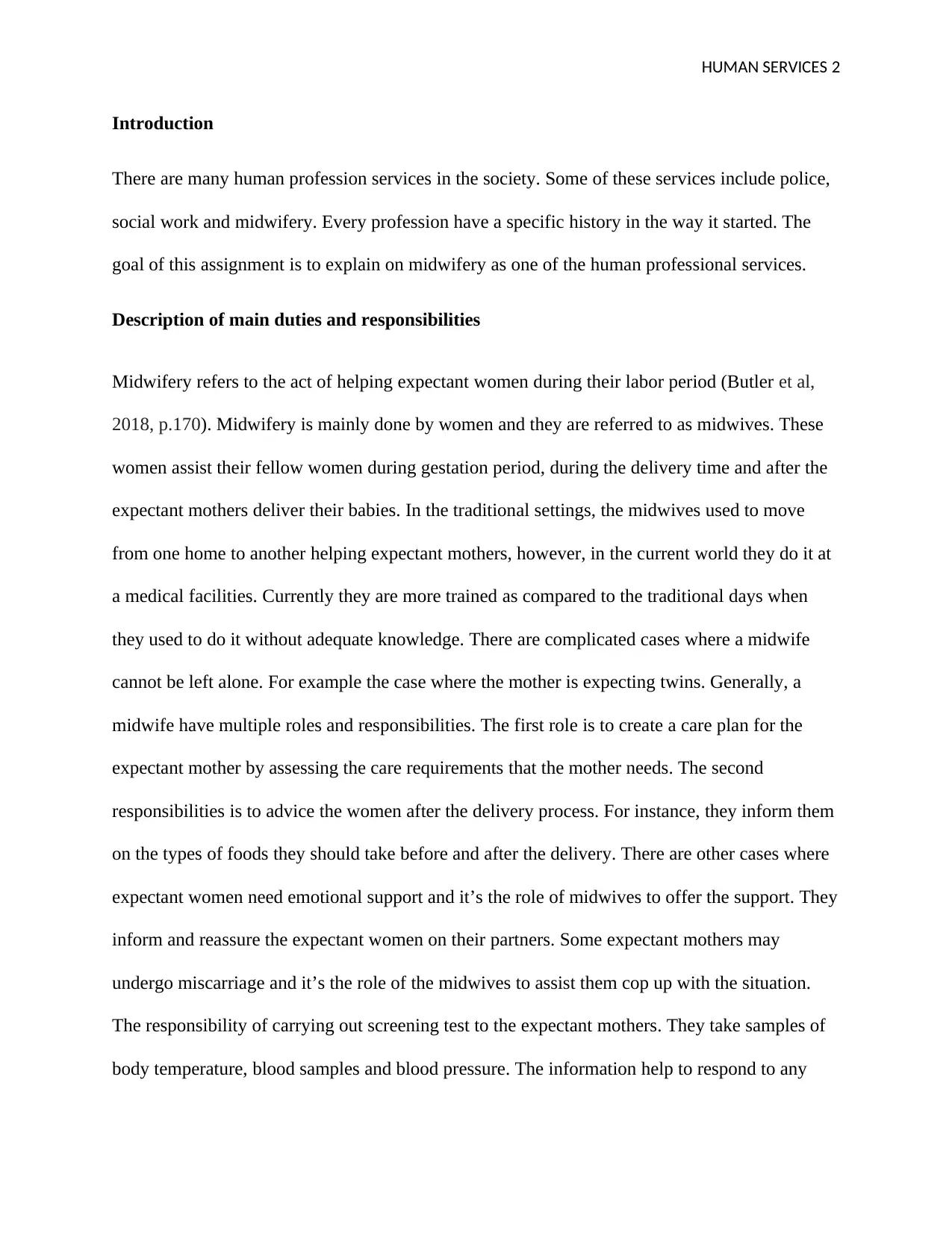
HUMAN SERVICES 2
Introduction
There are many human profession services in the society. Some of these services include police,
social work and midwifery. Every profession have a specific history in the way it started. The
goal of this assignment is to explain on midwifery as one of the human professional services.
Description of main duties and responsibilities
Midwifery refers to the act of helping expectant women during their labor period (Butler et al,
2018, p.170). Midwifery is mainly done by women and they are referred to as midwives. These
women assist their fellow women during gestation period, during the delivery time and after the
expectant mothers deliver their babies. In the traditional settings, the midwives used to move
from one home to another helping expectant mothers, however, in the current world they do it at
a medical facilities. Currently they are more trained as compared to the traditional days when
they used to do it without adequate knowledge. There are complicated cases where a midwife
cannot be left alone. For example the case where the mother is expecting twins. Generally, a
midwife have multiple roles and responsibilities. The first role is to create a care plan for the
expectant mother by assessing the care requirements that the mother needs. The second
responsibilities is to advice the women after the delivery process. For instance, they inform them
on the types of foods they should take before and after the delivery. There are other cases where
expectant women need emotional support and it’s the role of midwives to offer the support. They
inform and reassure the expectant women on their partners. Some expectant mothers may
undergo miscarriage and it’s the role of the midwives to assist them cop up with the situation.
The responsibility of carrying out screening test to the expectant mothers. They take samples of
body temperature, blood samples and blood pressure. The information help to respond to any
Introduction
There are many human profession services in the society. Some of these services include police,
social work and midwifery. Every profession have a specific history in the way it started. The
goal of this assignment is to explain on midwifery as one of the human professional services.
Description of main duties and responsibilities
Midwifery refers to the act of helping expectant women during their labor period (Butler et al,
2018, p.170). Midwifery is mainly done by women and they are referred to as midwives. These
women assist their fellow women during gestation period, during the delivery time and after the
expectant mothers deliver their babies. In the traditional settings, the midwives used to move
from one home to another helping expectant mothers, however, in the current world they do it at
a medical facilities. Currently they are more trained as compared to the traditional days when
they used to do it without adequate knowledge. There are complicated cases where a midwife
cannot be left alone. For example the case where the mother is expecting twins. Generally, a
midwife have multiple roles and responsibilities. The first role is to create a care plan for the
expectant mother by assessing the care requirements that the mother needs. The second
responsibilities is to advice the women after the delivery process. For instance, they inform them
on the types of foods they should take before and after the delivery. There are other cases where
expectant women need emotional support and it’s the role of midwives to offer the support. They
inform and reassure the expectant women on their partners. Some expectant mothers may
undergo miscarriage and it’s the role of the midwives to assist them cop up with the situation.
The responsibility of carrying out screening test to the expectant mothers. They take samples of
body temperature, blood samples and blood pressure. The information help to respond to any
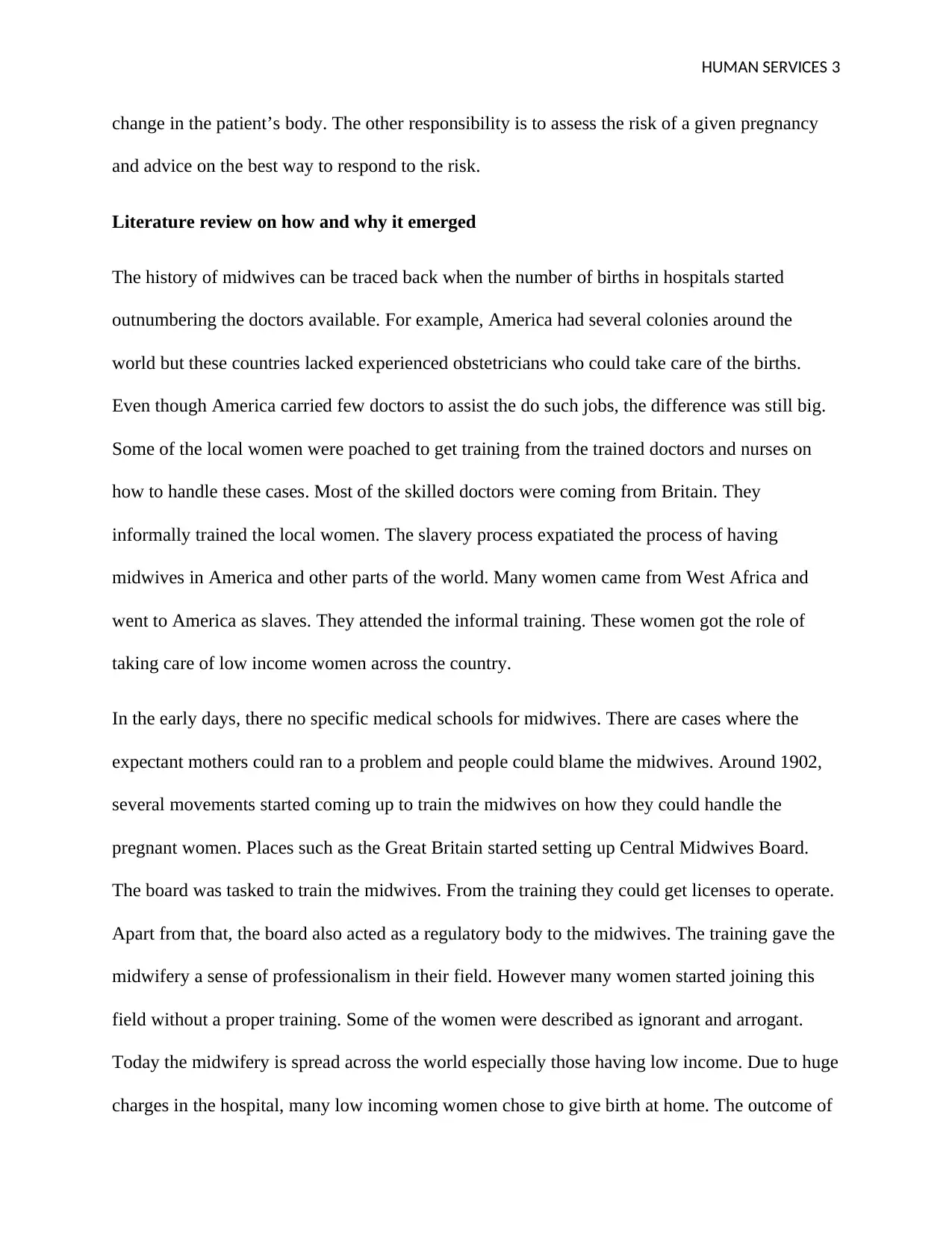
HUMAN SERVICES 3
change in the patient’s body. The other responsibility is to assess the risk of a given pregnancy
and advice on the best way to respond to the risk.
Literature review on how and why it emerged
The history of midwives can be traced back when the number of births in hospitals started
outnumbering the doctors available. For example, America had several colonies around the
world but these countries lacked experienced obstetricians who could take care of the births.
Even though America carried few doctors to assist the do such jobs, the difference was still big.
Some of the local women were poached to get training from the trained doctors and nurses on
how to handle these cases. Most of the skilled doctors were coming from Britain. They
informally trained the local women. The slavery process expatiated the process of having
midwives in America and other parts of the world. Many women came from West Africa and
went to America as slaves. They attended the informal training. These women got the role of
taking care of low income women across the country.
In the early days, there no specific medical schools for midwives. There are cases where the
expectant mothers could ran to a problem and people could blame the midwives. Around 1902,
several movements started coming up to train the midwives on how they could handle the
pregnant women. Places such as the Great Britain started setting up Central Midwives Board.
The board was tasked to train the midwives. From the training they could get licenses to operate.
Apart from that, the board also acted as a regulatory body to the midwives. The training gave the
midwifery a sense of professionalism in their field. However many women started joining this
field without a proper training. Some of the women were described as ignorant and arrogant.
Today the midwifery is spread across the world especially those having low income. Due to huge
charges in the hospital, many low incoming women chose to give birth at home. The outcome of
change in the patient’s body. The other responsibility is to assess the risk of a given pregnancy
and advice on the best way to respond to the risk.
Literature review on how and why it emerged
The history of midwives can be traced back when the number of births in hospitals started
outnumbering the doctors available. For example, America had several colonies around the
world but these countries lacked experienced obstetricians who could take care of the births.
Even though America carried few doctors to assist the do such jobs, the difference was still big.
Some of the local women were poached to get training from the trained doctors and nurses on
how to handle these cases. Most of the skilled doctors were coming from Britain. They
informally trained the local women. The slavery process expatiated the process of having
midwives in America and other parts of the world. Many women came from West Africa and
went to America as slaves. They attended the informal training. These women got the role of
taking care of low income women across the country.
In the early days, there no specific medical schools for midwives. There are cases where the
expectant mothers could ran to a problem and people could blame the midwives. Around 1902,
several movements started coming up to train the midwives on how they could handle the
pregnant women. Places such as the Great Britain started setting up Central Midwives Board.
The board was tasked to train the midwives. From the training they could get licenses to operate.
Apart from that, the board also acted as a regulatory body to the midwives. The training gave the
midwifery a sense of professionalism in their field. However many women started joining this
field without a proper training. Some of the women were described as ignorant and arrogant.
Today the midwifery is spread across the world especially those having low income. Due to huge
charges in the hospital, many low incoming women chose to give birth at home. The outcome of
⊘ This is a preview!⊘
Do you want full access?
Subscribe today to unlock all pages.

Trusted by 1+ million students worldwide
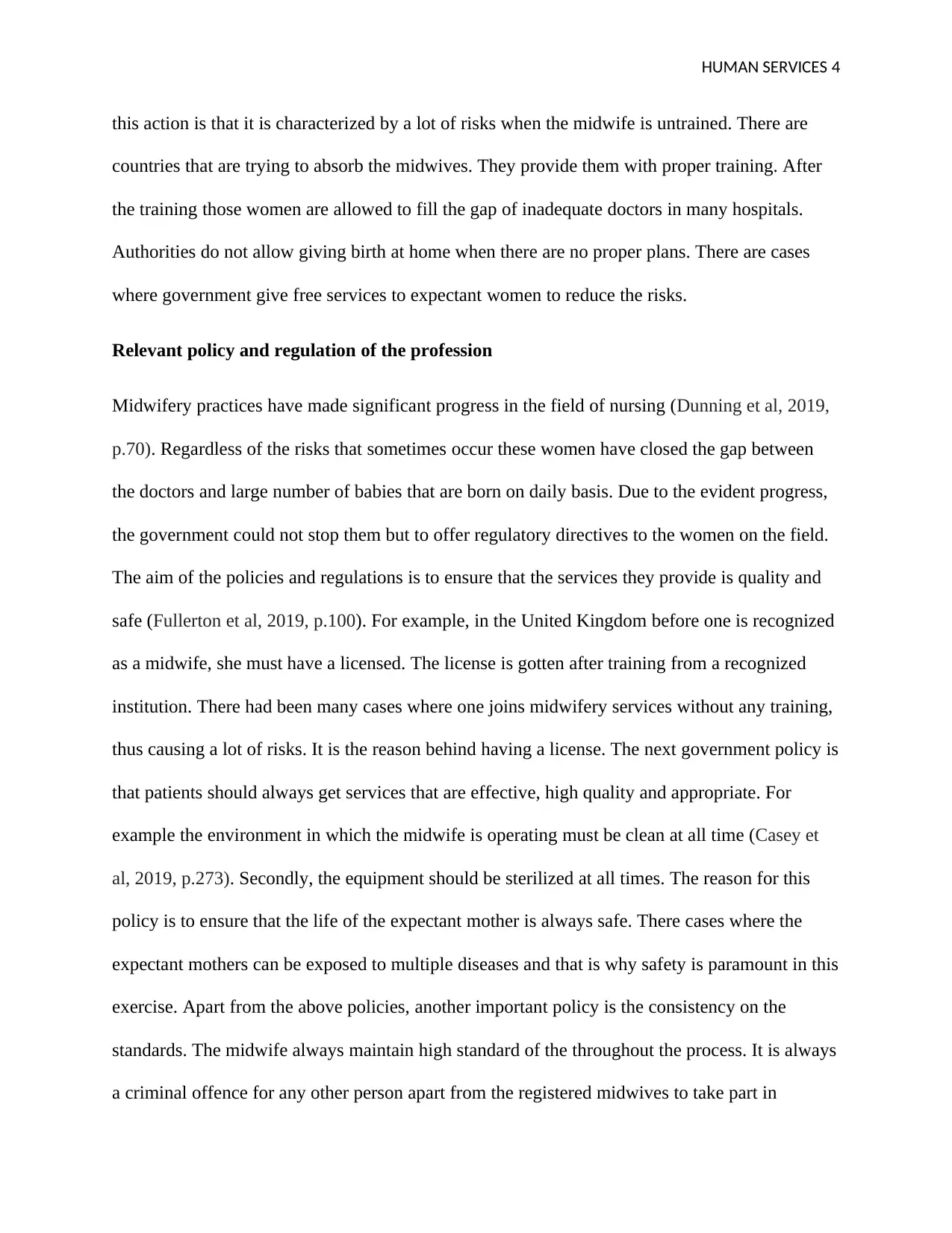
HUMAN SERVICES 4
this action is that it is characterized by a lot of risks when the midwife is untrained. There are
countries that are trying to absorb the midwives. They provide them with proper training. After
the training those women are allowed to fill the gap of inadequate doctors in many hospitals.
Authorities do not allow giving birth at home when there are no proper plans. There are cases
where government give free services to expectant women to reduce the risks.
Relevant policy and regulation of the profession
Midwifery practices have made significant progress in the field of nursing (Dunning et al, 2019,
p.70). Regardless of the risks that sometimes occur these women have closed the gap between
the doctors and large number of babies that are born on daily basis. Due to the evident progress,
the government could not stop them but to offer regulatory directives to the women on the field.
The aim of the policies and regulations is to ensure that the services they provide is quality and
safe (Fullerton et al, 2019, p.100). For example, in the United Kingdom before one is recognized
as a midwife, she must have a licensed. The license is gotten after training from a recognized
institution. There had been many cases where one joins midwifery services without any training,
thus causing a lot of risks. It is the reason behind having a license. The next government policy is
that patients should always get services that are effective, high quality and appropriate. For
example the environment in which the midwife is operating must be clean at all time (Casey et
al, 2019, p.273). Secondly, the equipment should be sterilized at all times. The reason for this
policy is to ensure that the life of the expectant mother is always safe. There cases where the
expectant mothers can be exposed to multiple diseases and that is why safety is paramount in this
exercise. Apart from the above policies, another important policy is the consistency on the
standards. The midwife always maintain high standard of the throughout the process. It is always
a criminal offence for any other person apart from the registered midwives to take part in
this action is that it is characterized by a lot of risks when the midwife is untrained. There are
countries that are trying to absorb the midwives. They provide them with proper training. After
the training those women are allowed to fill the gap of inadequate doctors in many hospitals.
Authorities do not allow giving birth at home when there are no proper plans. There are cases
where government give free services to expectant women to reduce the risks.
Relevant policy and regulation of the profession
Midwifery practices have made significant progress in the field of nursing (Dunning et al, 2019,
p.70). Regardless of the risks that sometimes occur these women have closed the gap between
the doctors and large number of babies that are born on daily basis. Due to the evident progress,
the government could not stop them but to offer regulatory directives to the women on the field.
The aim of the policies and regulations is to ensure that the services they provide is quality and
safe (Fullerton et al, 2019, p.100). For example, in the United Kingdom before one is recognized
as a midwife, she must have a licensed. The license is gotten after training from a recognized
institution. There had been many cases where one joins midwifery services without any training,
thus causing a lot of risks. It is the reason behind having a license. The next government policy is
that patients should always get services that are effective, high quality and appropriate. For
example the environment in which the midwife is operating must be clean at all time (Casey et
al, 2019, p.273). Secondly, the equipment should be sterilized at all times. The reason for this
policy is to ensure that the life of the expectant mother is always safe. There cases where the
expectant mothers can be exposed to multiple diseases and that is why safety is paramount in this
exercise. Apart from the above policies, another important policy is the consistency on the
standards. The midwife always maintain high standard of the throughout the process. It is always
a criminal offence for any other person apart from the registered midwives to take part in
Paraphrase This Document
Need a fresh take? Get an instant paraphrase of this document with our AI Paraphraser
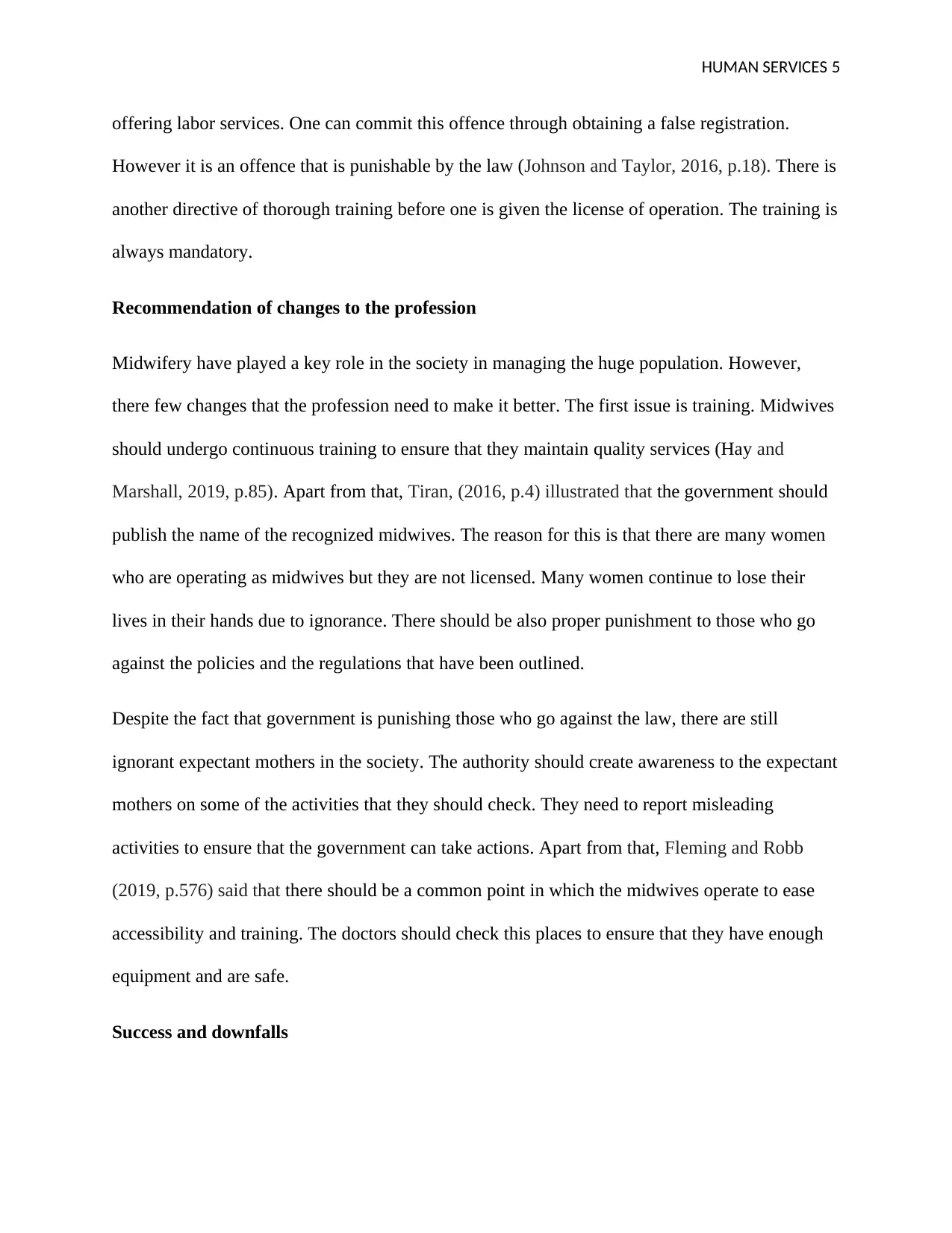
HUMAN SERVICES 5
offering labor services. One can commit this offence through obtaining a false registration.
However it is an offence that is punishable by the law (Johnson and Taylor, 2016, p.18). There is
another directive of thorough training before one is given the license of operation. The training is
always mandatory.
Recommendation of changes to the profession
Midwifery have played a key role in the society in managing the huge population. However,
there few changes that the profession need to make it better. The first issue is training. Midwives
should undergo continuous training to ensure that they maintain quality services (Hay and
Marshall, 2019, p.85). Apart from that, Tiran, (2016, p.4) illustrated that the government should
publish the name of the recognized midwives. The reason for this is that there are many women
who are operating as midwives but they are not licensed. Many women continue to lose their
lives in their hands due to ignorance. There should be also proper punishment to those who go
against the policies and the regulations that have been outlined.
Despite the fact that government is punishing those who go against the law, there are still
ignorant expectant mothers in the society. The authority should create awareness to the expectant
mothers on some of the activities that they should check. They need to report misleading
activities to ensure that the government can take actions. Apart from that, Fleming and Robb
(2019, p.576) said that there should be a common point in which the midwives operate to ease
accessibility and training. The doctors should check this places to ensure that they have enough
equipment and are safe.
Success and downfalls
offering labor services. One can commit this offence through obtaining a false registration.
However it is an offence that is punishable by the law (Johnson and Taylor, 2016, p.18). There is
another directive of thorough training before one is given the license of operation. The training is
always mandatory.
Recommendation of changes to the profession
Midwifery have played a key role in the society in managing the huge population. However,
there few changes that the profession need to make it better. The first issue is training. Midwives
should undergo continuous training to ensure that they maintain quality services (Hay and
Marshall, 2019, p.85). Apart from that, Tiran, (2016, p.4) illustrated that the government should
publish the name of the recognized midwives. The reason for this is that there are many women
who are operating as midwives but they are not licensed. Many women continue to lose their
lives in their hands due to ignorance. There should be also proper punishment to those who go
against the policies and the regulations that have been outlined.
Despite the fact that government is punishing those who go against the law, there are still
ignorant expectant mothers in the society. The authority should create awareness to the expectant
mothers on some of the activities that they should check. They need to report misleading
activities to ensure that the government can take actions. Apart from that, Fleming and Robb
(2019, p.576) said that there should be a common point in which the midwives operate to ease
accessibility and training. The doctors should check this places to ensure that they have enough
equipment and are safe.
Success and downfalls
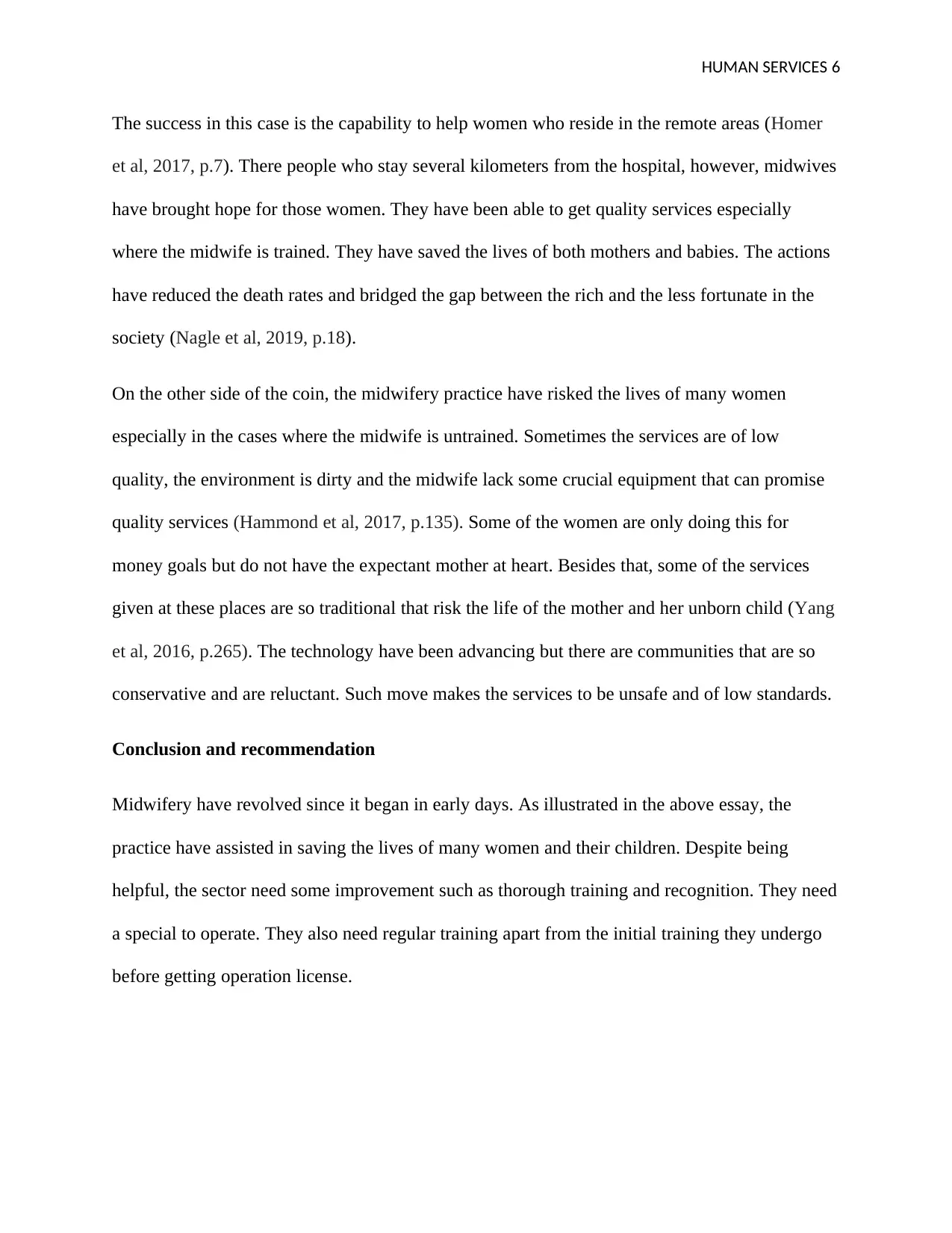
HUMAN SERVICES 6
The success in this case is the capability to help women who reside in the remote areas (Homer
et al, 2017, p.7). There people who stay several kilometers from the hospital, however, midwives
have brought hope for those women. They have been able to get quality services especially
where the midwife is trained. They have saved the lives of both mothers and babies. The actions
have reduced the death rates and bridged the gap between the rich and the less fortunate in the
society (Nagle et al, 2019, p.18).
On the other side of the coin, the midwifery practice have risked the lives of many women
especially in the cases where the midwife is untrained. Sometimes the services are of low
quality, the environment is dirty and the midwife lack some crucial equipment that can promise
quality services (Hammond et al, 2017, p.135). Some of the women are only doing this for
money goals but do not have the expectant mother at heart. Besides that, some of the services
given at these places are so traditional that risk the life of the mother and her unborn child (Yang
et al, 2016, p.265). The technology have been advancing but there are communities that are so
conservative and are reluctant. Such move makes the services to be unsafe and of low standards.
Conclusion and recommendation
Midwifery have revolved since it began in early days. As illustrated in the above essay, the
practice have assisted in saving the lives of many women and their children. Despite being
helpful, the sector need some improvement such as thorough training and recognition. They need
a special to operate. They also need regular training apart from the initial training they undergo
before getting operation license.
The success in this case is the capability to help women who reside in the remote areas (Homer
et al, 2017, p.7). There people who stay several kilometers from the hospital, however, midwives
have brought hope for those women. They have been able to get quality services especially
where the midwife is trained. They have saved the lives of both mothers and babies. The actions
have reduced the death rates and bridged the gap between the rich and the less fortunate in the
society (Nagle et al, 2019, p.18).
On the other side of the coin, the midwifery practice have risked the lives of many women
especially in the cases where the midwife is untrained. Sometimes the services are of low
quality, the environment is dirty and the midwife lack some crucial equipment that can promise
quality services (Hammond et al, 2017, p.135). Some of the women are only doing this for
money goals but do not have the expectant mother at heart. Besides that, some of the services
given at these places are so traditional that risk the life of the mother and her unborn child (Yang
et al, 2016, p.265). The technology have been advancing but there are communities that are so
conservative and are reluctant. Such move makes the services to be unsafe and of low standards.
Conclusion and recommendation
Midwifery have revolved since it began in early days. As illustrated in the above essay, the
practice have assisted in saving the lives of many women and their children. Despite being
helpful, the sector need some improvement such as thorough training and recognition. They need
a special to operate. They also need regular training apart from the initial training they undergo
before getting operation license.
⊘ This is a preview!⊘
Do you want full access?
Subscribe today to unlock all pages.

Trusted by 1+ million students worldwide
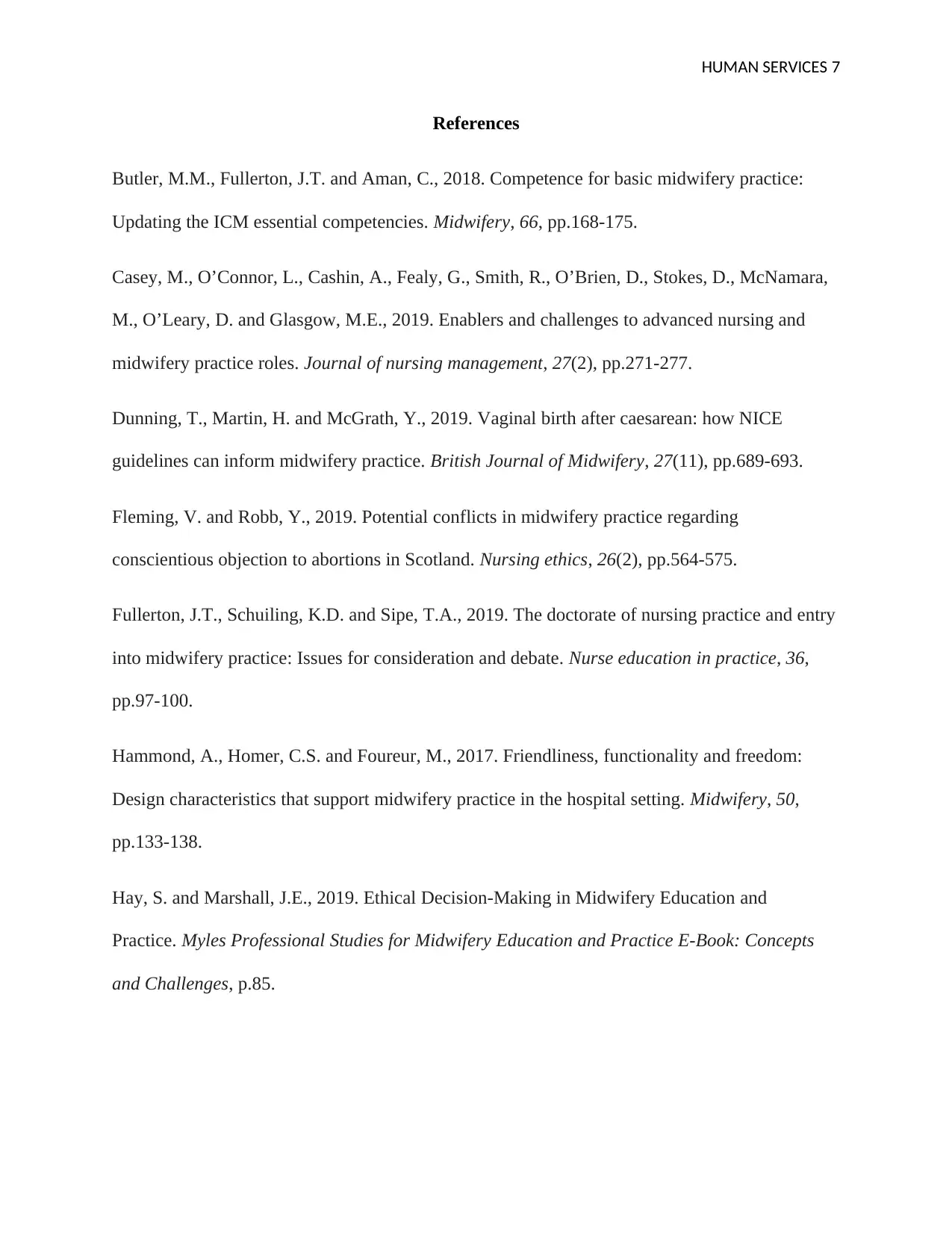
HUMAN SERVICES 7
References
Butler, M.M., Fullerton, J.T. and Aman, C., 2018. Competence for basic midwifery practice:
Updating the ICM essential competencies. Midwifery, 66, pp.168-175.
Casey, M., O’Connor, L., Cashin, A., Fealy, G., Smith, R., O’Brien, D., Stokes, D., McNamara,
M., O’Leary, D. and Glasgow, M.E., 2019. Enablers and challenges to advanced nursing and
midwifery practice roles. Journal of nursing management, 27(2), pp.271-277.
Dunning, T., Martin, H. and McGrath, Y., 2019. Vaginal birth after caesarean: how NICE
guidelines can inform midwifery practice. British Journal of Midwifery, 27(11), pp.689-693.
Fleming, V. and Robb, Y., 2019. Potential conflicts in midwifery practice regarding
conscientious objection to abortions in Scotland. Nursing ethics, 26(2), pp.564-575.
Fullerton, J.T., Schuiling, K.D. and Sipe, T.A., 2019. The doctorate of nursing practice and entry
into midwifery practice: Issues for consideration and debate. Nurse education in practice, 36,
pp.97-100.
Hammond, A., Homer, C.S. and Foureur, M., 2017. Friendliness, functionality and freedom:
Design characteristics that support midwifery practice in the hospital setting. Midwifery, 50,
pp.133-138.
Hay, S. and Marshall, J.E., 2019. Ethical Decision-Making in Midwifery Education and
Practice. Myles Professional Studies for Midwifery Education and Practice E-Book: Concepts
and Challenges, p.85.
References
Butler, M.M., Fullerton, J.T. and Aman, C., 2018. Competence for basic midwifery practice:
Updating the ICM essential competencies. Midwifery, 66, pp.168-175.
Casey, M., O’Connor, L., Cashin, A., Fealy, G., Smith, R., O’Brien, D., Stokes, D., McNamara,
M., O’Leary, D. and Glasgow, M.E., 2019. Enablers and challenges to advanced nursing and
midwifery practice roles. Journal of nursing management, 27(2), pp.271-277.
Dunning, T., Martin, H. and McGrath, Y., 2019. Vaginal birth after caesarean: how NICE
guidelines can inform midwifery practice. British Journal of Midwifery, 27(11), pp.689-693.
Fleming, V. and Robb, Y., 2019. Potential conflicts in midwifery practice regarding
conscientious objection to abortions in Scotland. Nursing ethics, 26(2), pp.564-575.
Fullerton, J.T., Schuiling, K.D. and Sipe, T.A., 2019. The doctorate of nursing practice and entry
into midwifery practice: Issues for consideration and debate. Nurse education in practice, 36,
pp.97-100.
Hammond, A., Homer, C.S. and Foureur, M., 2017. Friendliness, functionality and freedom:
Design characteristics that support midwifery practice in the hospital setting. Midwifery, 50,
pp.133-138.
Hay, S. and Marshall, J.E., 2019. Ethical Decision-Making in Midwifery Education and
Practice. Myles Professional Studies for Midwifery Education and Practice E-Book: Concepts
and Challenges, p.85.
Paraphrase This Document
Need a fresh take? Get an instant paraphrase of this document with our AI Paraphraser
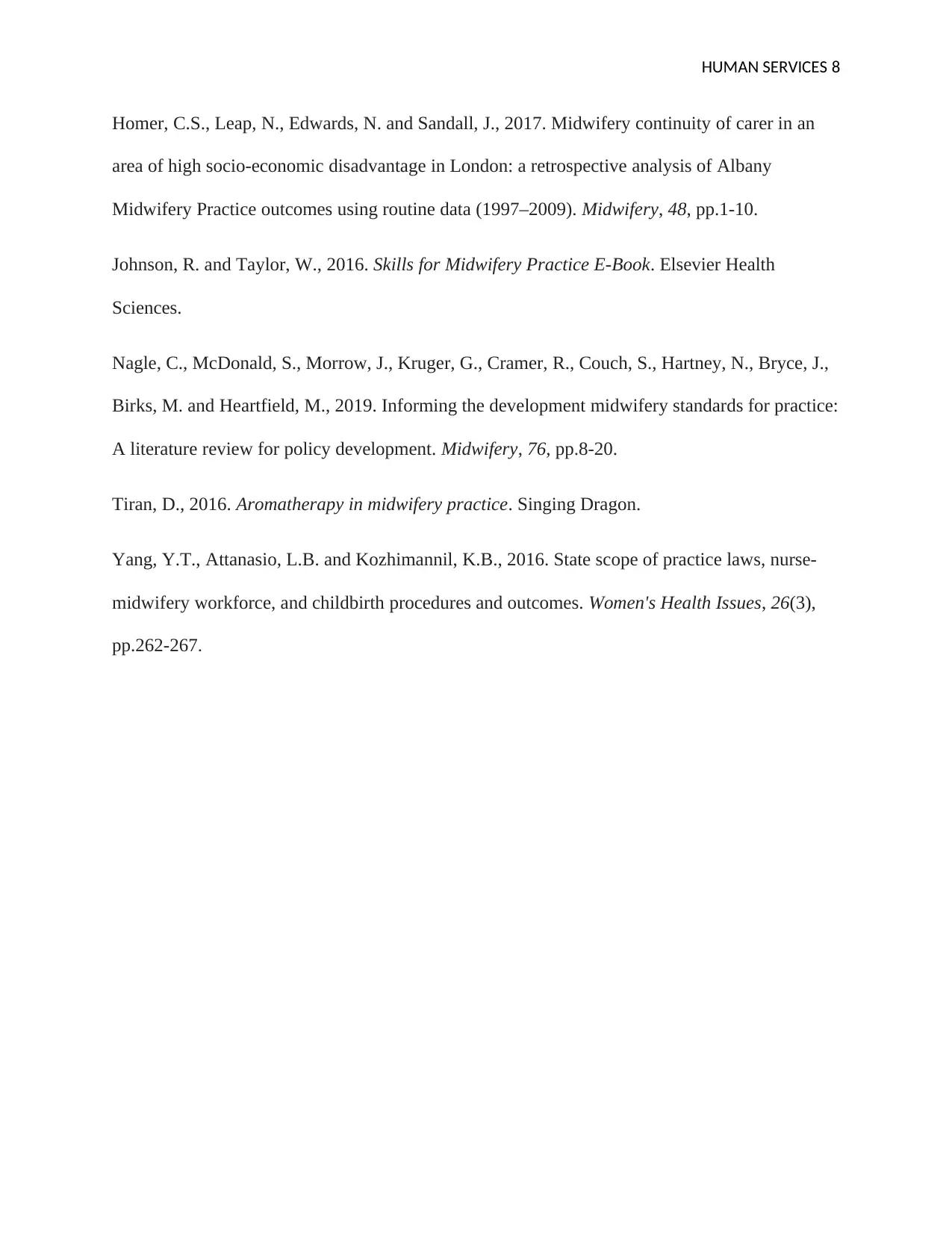
HUMAN SERVICES 8
Homer, C.S., Leap, N., Edwards, N. and Sandall, J., 2017. Midwifery continuity of carer in an
area of high socio-economic disadvantage in London: a retrospective analysis of Albany
Midwifery Practice outcomes using routine data (1997–2009). Midwifery, 48, pp.1-10.
Johnson, R. and Taylor, W., 2016. Skills for Midwifery Practice E-Book. Elsevier Health
Sciences.
Nagle, C., McDonald, S., Morrow, J., Kruger, G., Cramer, R., Couch, S., Hartney, N., Bryce, J.,
Birks, M. and Heartfield, M., 2019. Informing the development midwifery standards for practice:
A literature review for policy development. Midwifery, 76, pp.8-20.
Tiran, D., 2016. Aromatherapy in midwifery practice. Singing Dragon.
Yang, Y.T., Attanasio, L.B. and Kozhimannil, K.B., 2016. State scope of practice laws, nurse-
midwifery workforce, and childbirth procedures and outcomes. Women's Health Issues, 26(3),
pp.262-267.
Homer, C.S., Leap, N., Edwards, N. and Sandall, J., 2017. Midwifery continuity of carer in an
area of high socio-economic disadvantage in London: a retrospective analysis of Albany
Midwifery Practice outcomes using routine data (1997–2009). Midwifery, 48, pp.1-10.
Johnson, R. and Taylor, W., 2016. Skills for Midwifery Practice E-Book. Elsevier Health
Sciences.
Nagle, C., McDonald, S., Morrow, J., Kruger, G., Cramer, R., Couch, S., Hartney, N., Bryce, J.,
Birks, M. and Heartfield, M., 2019. Informing the development midwifery standards for practice:
A literature review for policy development. Midwifery, 76, pp.8-20.
Tiran, D., 2016. Aromatherapy in midwifery practice. Singing Dragon.
Yang, Y.T., Attanasio, L.B. and Kozhimannil, K.B., 2016. State scope of practice laws, nurse-
midwifery workforce, and childbirth procedures and outcomes. Women's Health Issues, 26(3),
pp.262-267.
1 out of 8
Related Documents
Your All-in-One AI-Powered Toolkit for Academic Success.
+13062052269
info@desklib.com
Available 24*7 on WhatsApp / Email
![[object Object]](/_next/static/media/star-bottom.7253800d.svg)
Unlock your academic potential
Copyright © 2020–2025 A2Z Services. All Rights Reserved. Developed and managed by ZUCOL.




